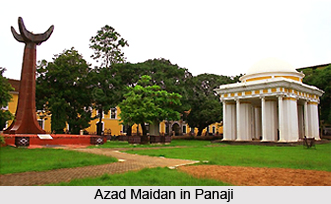 The monuments of Panaji bear the stamp of both Portuguese as well as Muslim rule. Also known as Panjim, Panaji is the capital of the Union territory of Goa, Daman and Diu, and was a centre of power for both the Portuguese colonialists as well as Muslim rulers of the Adil Shahi dynasty of Bijapur. It is often referred to as New Goa, as distinct and separate from the old capital of Velha Goa or old Goa.
The monuments of Panaji bear the stamp of both Portuguese as well as Muslim rule. Also known as Panjim, Panaji is the capital of the Union territory of Goa, Daman and Diu, and was a centre of power for both the Portuguese colonialists as well as Muslim rulers of the Adil Shahi dynasty of Bijapur. It is often referred to as New Goa, as distinct and separate from the old capital of Velha Goa or old Goa.
The earliest reference to the town is in an inscription of a king of the Kadamba dynasty in 1170 AD. Under Muslim rule the town was notable for its castle, built by Yusuf Adil Shah, and it was from here that the Bijapur forces offered such vigorous resistance to Albuquerque in 1510. During the first century of Portuguese rule, Panaji was the temporary residence of the Viceroys and Governors on their arrival from Portugal, and it became their permanent residence in 1759. In 1843 it was formally declared the capital of Portuguese India.
Based on Portuguese influence, Panaji is laid out in a typical grid pattern, centred on a Church in a civic square. The river front extends from Gaspar Dias to the bridge over the Mandovi River in a succession of open spaces, pretty vernacular houses with stucco walls and tiled roofs, and administrative buildings. Prime among the monuments of Panaji are a number of churches, buildings and forts, most of which have been constructed under Portuguese and Muslim influence.
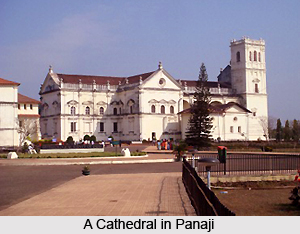 Historical Monuments of Panaji
Historical Monuments of Panaji
A number of monuments are found in Panaji, marked for the historical legacy they bear. At the heart of town is the Largo da Igreja or Church Square. The full elegance of the Portuguese style of architecture is reflected here. In the centre of the square is a 12 meter high column that was the base of the statue of Vasco Da Gama before Independence. Later the statue was shifted to the museum at Old Goa. Now it hoists the Ashokan Pillar, Indian national emblem.
The oldest historical monument in Panaji is the Idalco or the palace of the Adil Shahi Kings. Once the castle of the Adil Shahi Sultans of Bijapur, it was rebuilt in 1615 by the Portuguese Viceroy Jeronimo de Azevedo. Until 1759 it was used as a residence by the Viceroy and in 1843, it became the Secretariat. It now houses the Goan state legislature.
The Archaeological Museum also known as the Museum of Christian Art was built in the year 1964 .It is one of the tourist hotspots in Goa. There are eight sections in the museum in the eight different galleries. A number of displays of the Portuguese era may be seen here, including sixty portraits of the Governors and viceroys of Goa.A fine collection of Goan handicrafts and cultural art are also found here, made of gold, precious stones, ivory etc Also found here is a huge collection of Hindu Gods and Goddesses. Found here is a standing statue of Lord Vishnu along with Godess Lakshmi on one side and Garuda on the other. There are also works from the Palaeolithic age, Neolithic Celts, excavated materials from Chandnor etc.
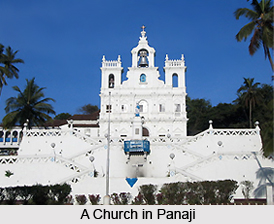 The Azad maidan is one of the most famous landmarks of Goa. Contained in it are a number of monuments and structures constructed in the Greek architectural style.
The Azad maidan is one of the most famous landmarks of Goa. Contained in it are a number of monuments and structures constructed in the Greek architectural style.
Found here is the TB Cunha memorial built by the Portuguese to commemorate Alfonso de Alberqueue, their great adventure. Originally there was a two metre tall bronze statue of the said adventurer. It now contains the remains of a great Goan intellectual and freedom fighter, Dr.Tristao de Braganza Cunha. At the pavilion in the centre is his statue. There is a monuments beside the statue dedicate to those who fought to free Goa from Portuguese rule.
Lying to the West of the Maidan is the Police Headquarters, previously the barracks and military headquarters of the Portuguese army built in 1832.
Located at the far end on ten maidan is the Institute of Menezes Braganza. It contains a massive library, originally known as the Vasco da Gama institute.
Opposite this is a monuments dedicated to victims who died in a drowning incident in the Mandovi river in 1901.
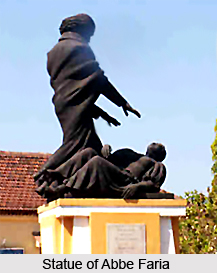 Towards the end of the square is the Government Printing Press, and behind this building are a number of state government offices.
Towards the end of the square is the Government Printing Press, and behind this building are a number of state government offices.
The Aga Khan Jamatkhana is situated near the Azad Maidan and is especially for the Ismalia sect of Shia Muslims.
At Cabo on the western tip of Panaji district is Raj Niwas, the official residence of the Lieutenant-Govern or of the Union Territory of Goa, Daman and Diu. In 1594 a Franciscan convent was built here. In the 17th century it was selected as the temporary residence of the Archbishop of Goa owing to its salubrious position and panoramic view. Further changes were carried out by the Count of Rio Parde (1816-21) and, with the abolition of some of the religious orders in Goa; it was converted into a summer palace for the Governors. British troops were garrisoned here between 1779 and 1813 to defend Goa from the French. The Raj Niwas is a large building of mud and laterite set in landscaped gardens.
The eastern part of the town is a middle-class residential area Fontainhas. It is a rather old part of the town located between the Rua de Orm creek and the hillock of Altinho. Fontainhas gets its name from the various springs found in this area. The narrow streets of this Christian dominated region are reminiscent of Portuguese Goa.
The Campal or Riverside Boulevard is one of the most picturesque parts of the town, with delightful views across the river and glimpses of Aguada Fort in the distance.
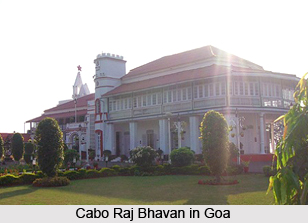 The Statue of Abbe Faria is another historical monument of Goa. Located just beside the secretariat, the statue depicts a priest hypnotising a woman. The significance of this pose is that Abbe Faria was the originator of hypnotism through suggestions. The statue is built in recognition of that achievement. The priest was immortalized Alexander Dumas` famous book, The Count of Monte Cristo.
The Statue of Abbe Faria is another historical monument of Goa. Located just beside the secretariat, the statue depicts a priest hypnotising a woman. The significance of this pose is that Abbe Faria was the originator of hypnotism through suggestions. The statue is built in recognition of that achievement. The priest was immortalized Alexander Dumas` famous book, The Count of Monte Cristo.
Religious Monuments of Panaji
Most of the religious monuments in Goa are Christrian in nature. However, this is not to say that mosques and temples are not found, only they are not as many in number.
One of the most famous among the various beautiful churches of Panjim is the Church of the Immaculate Conception. It was built in 1541 atop a hill called the Bairro Altos de Pilotos as a local landmark for sailors. Designed in Portuguese Baroque style, it was modelled on the Church at Reis Magos. It has a grand balustraded staircase and tall, twin towers. The bell in the tower is the second largest in Goa. Originally a small chapel, it was renovated in 1619. The image of Our Lady of Fatima can be found on one of the altars. There are two major feasts at the church each year: on 13 May and 8 December.
The Church of St Sebastian is locate at the end of the city and is still retains its colonial construction. It was constructed in 1592 after the missionaries converted a private Hindu Temple into this Church. The original temple called the "Pandavachem deul" belonged to a descendant of the Pandavas, Suntu Naique Sar Dessai. He converted to Christianity in 1560, and the date of the feast of the Patron Saint was fixed on the day of his conversion. One of the main attractions of the Church is an almost lifelike crucifix brought to the chapel in 1812. Legend has it that it was initially hung at the palace of the inquisition at old Goa, supposedly to create fear among the hearts of those being interrogated as Christ`s eyes in the image are unusually open
The Shrine of Our Lady of Fatima, in the compound of Don Bosco High School, was built in 1970.
A temple is also found here, the first Hindu temple allowed to be built in Goa by the Portuguese after almost three hundred years. In 1818 the Portuguese authorities gave their consent for the construction of this temple, and it was finally completed in 1983.The deity housed in this temple originally belonged to the village of Taleigo. It was moved to Bicholim in the sixteenth century to escape destruction at the hands of the Portuguese. Navaratri and Chaitra Purnima are the main festivals celebrated in this temple.
A Jama Masjid is also found here, possibly due to the Muslim influence of the Adil Shahi rulers.
The Jama Masjid lies near Church Square. It has no dome but can be identified by the star over the front entrance and the minarets. Built in the mid-18th century by Sulaiman Shet and Aba Shet, it was renovated in 1935. The mosque is an elegant sight with two beautiful towers which flank the entrance facade. This is surrounded by four minars. At the centre of these four minarets is a dome shaped kiosk, a thing of real beauty. Almost all Muslim festivals are celebrated here among much harmony.
A Jain Temple is also found at Panaji. It is a modern structure and one of the most important sites at the service of the Jains.
The monuments of Panaji are of great architectural interest not just within the city; they are counted prime among all the monuments of Goa.



















